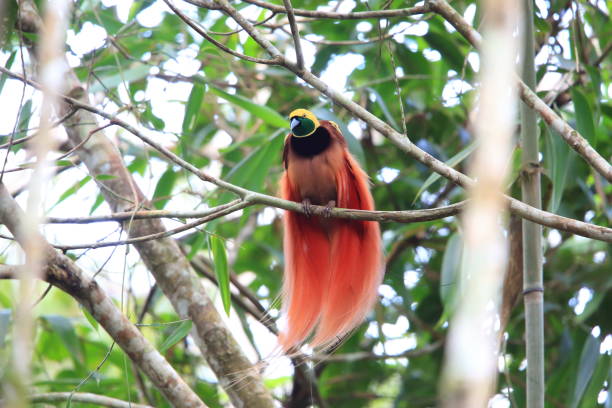ANIMAL: Raggiana Bird-of-Paradise Paradisaea raggiana Type of Animal: Songbird Habitat: Forest, forest edges, gardens, trees in open deforested areas Location(s): S & E New Guinea Appearance: Male has yellow cowl/hood, dark emerald green throat, maroon brown body/wings, yellow collar, blackish upper breast feathers, long black tail wires, large flank plumes varying from deep red to apricot-orange in color. Female much drabber than male being maroonish-brown & having much shorter tail. Both sexes have greyish-blue bill, greyish-brown feet, & yellow eyes. Food/Diet: Fruit, berries, insects, insect larvae, spiders, frogs, lizards, small snakes, nectar, seeds Status in Wild: Stable Conservation: Breeding in zoos & wildlife centers Lifestyle: Females are solitary. Males solitary or in small groups of 5-10. Males often display in leks (breeding aggregations). Additional Info: Called: Male: Cock Female: Hen Young: Chick Group: Party Weight: Male: 8.25-10.5 oz Female: 4.69-7.76 oz Young: 3 oz Gestation: 3 weeks Life Span: 12-16 years Height: Male: 1.11-1.12 ft Female: 1.08 ft Body Length: Male: 1.11-1.12 ft Female: 1.08 ft Tail Length: Male: 2.5-3 ft Female: 1-1.3 ft Main predators are snakes, raptors, cats, canids, monitor lizards, & rats. Males display in leks (breeding aggregations)-most often among clusters of tall slender trees. Males compete for best perches-more dominant males get best perches. Males raise tail feathers over head/back, hopping along branches w/ head lowered/raised & extending wings. Males also clap wings/shake heads. These birds are important seed dispersers. Sometimes hybridize w/ other bird-of-paradise species. Chicks fledge at 3-3.5 weeks but stay w/ mom for longer. Females typically rear 1-2 chicks. Males make loud crow-like calls during breeding periods. Bowl-shaped nests lined w/ horsehair-like material & usually 6.5-36 ft off the ground. Wings often produce mechanical sounds during courtship displays. While maturity reached at 2-3 years old, many males may not get full plumage until 6-7 years old. Fun Fact(s): Some local tribes believe these are “birds of the gods” & that they never touch ground. Natives use plumes as ceremonial headdresses. Some leks have been in continuous use for over 20 years. These birds along w/ other bird-of-paradise species inspired name of bird-of-paradise flowers. These birds national bird of Papua New Guinea. Also known as Count Raggi’s Bird-of-Paradise, kumul, & cenderawasih. In fact, Papua New Guinea’s national rugby team nicknamed “Kumuls” meaning “birds-of-paradise” in Tok Pisin language of that country.
